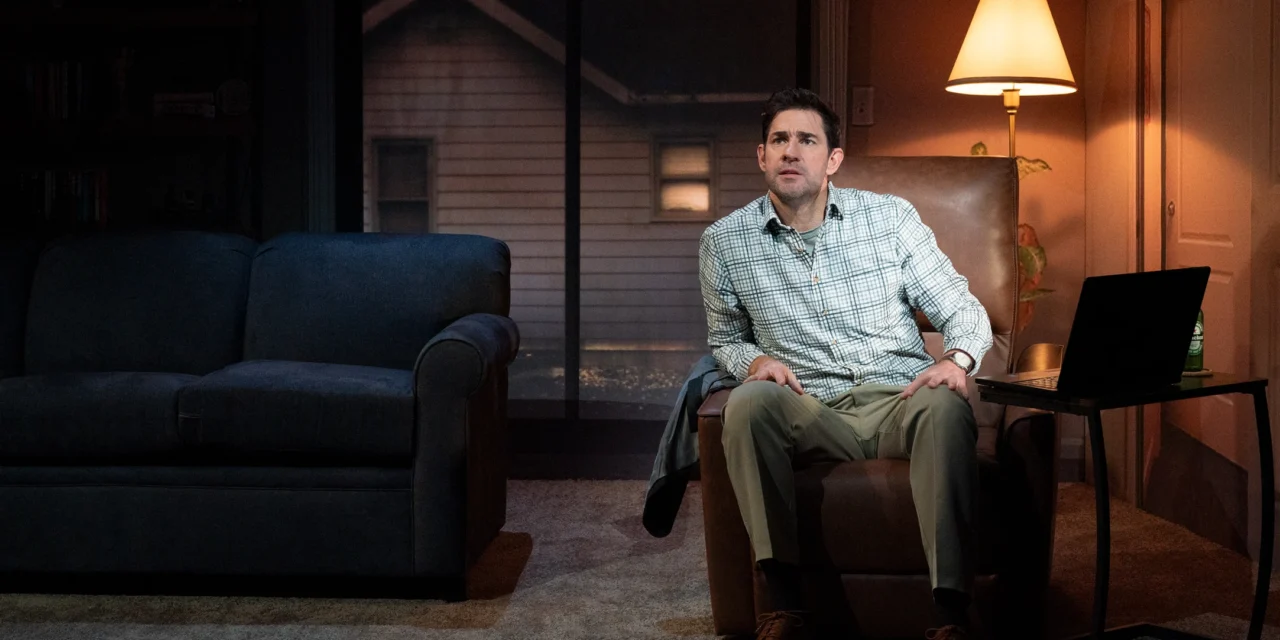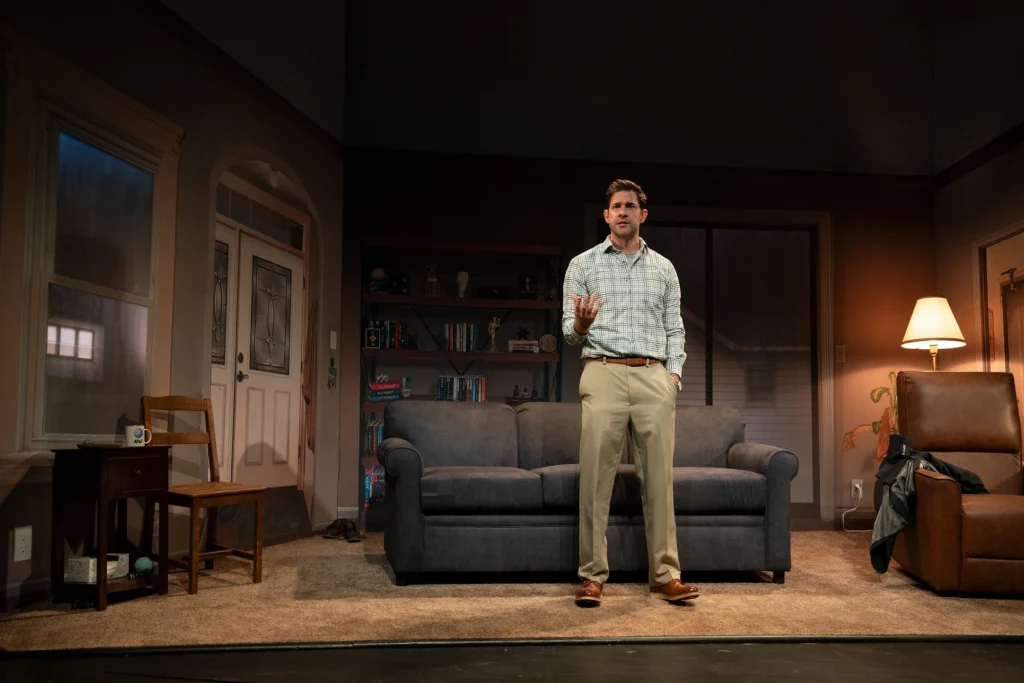Angry Alan is an ickily pointed cautionary tale about an ordinary guy who falls into the rabbit hole of the online manosphere and transforms into a serious prick. Written by the British playwright Penelope Skinner, it’s a solo show (mostly) that became a hit in the U.K. in 2018 after moving from the Aspen Fringe Festival to the Edinburgh Fringe Festival and then the West End. That production was directed by the author and starred her partner Donald Sage Mackay, with whom she developed the piece.
Now a new Off Broadway production has opened at Studio Seaview (the converted bank that used to be Second Stage), starring John Krasinski and directed by Sam Gold. Krasinski—the laid-back hunky star of The Office, A Quiet Place, Jack Ryan, and much more—is a compelling and winning presence, as always. His bright charisma is on full display in this show.
I’m not convinced, however, that his trademark charm is exactly the right aura for Roger, Skinner’s protagonist. Krasinski so thoroughly papers over Roger’s sublimated callousness with affability that the guy’s ugly turn near the end seems to come wholly out of the blue. The production left me wishing I’d seen Mackay for comparison.
Roger is a divorced 45-year-old who once earned a big salary at AT&T and drove a BMW but was laid off and now works as a supermarket dairy manager. He hasn’t seen his 14-year-old son in eight months and doesn’t understand why. He generally feels like a failure but his genial façade doesn’t seem toxic to begin with.
He comes off as a run-of-the-mill unreflective guy who drinks beer, watches ball games, and constantly reveals his limitations in passing remarks like “[my ex-wife’s post-partum depression] was extremely challenging for me,” and “[my son] isn’t one of those nerds who gets picked last for the sports teams.”
He now lives with his girlfriend Courtney, who recently reinvented herself in ways that threaten his normie worldview. She returned to college, changed her style, picked up her dropped art practice, and started hanging with artist types who do weird things like talk politics, grind their own coffee beans, and eat kimchi. Her latest t-shirt says, “Carry Yourself with the Confidence of a Mediocre White Man.”
Roger narrates the play as a direct address, replete with ingratiating phrases like “Do you ever do that” and “Why am I telling you that” that Krasinski handles effortlessly. He’s like a barstool windbag you want to avoid but don’t because he does reel you in. Improbably, it feels good to be treated like his buddy.
He’s also good at mimicking other people who are sometimes shown in pictures projected onto the walls of a living room set, cunningly designed by the collective called dots. The room walls are hazy and borderline cartoonish, framing just a few generic furniture pieces, and their dreary indistinctness poignantly reflects Roger’s lack of self-awareness.
Aimlessly surfing the internet one day, Roger comes across the men’s rights videos of a Jordan Peterson/Andrew Tate-like influencer named Angry Alan. He finds himself completely absorbed by their grievance-suffused claims, which touch his unexamined sense of humiliation and rage. Alan describes a “Gynocentric Society” in which triumphal feminism has flipped the old patriarchal power balance and left men depressed, shamed, and financially exploited, and calls for massive pushback. Roger feels he has finally found someone who understands him. His bad feelings are “maybe not actually all my fault. You know? Maybe what’s really to blame is the system.”
Most people in the New York audience will probably recognize Alan as a fraud who plays fast and loose with facts (sowing doubt about rape statistics, for instance) and mercilessly squeezing his followers for money. Roger can’t see that, though, and falls under Alan’s spell. He calls it his “red pill” moment and, without telling Courtney (whose reaction he fears), sends Alan’s videos to all his contacts, including his son. He then cancels a child support payment to buy an exorbitantly priced ticket to hear Alan speak at a conference.
When he finally does tell Courtney about this new attachment, she tries to understand and school him, but he proves unteachable and unreachable. He just bumptiously repeats Alan’s talking points about, say, the confusing “hypocrisy of modern women” who want both equality and to enjoy the cheap thrills of Fifty Shades of Grey. “You gotta choose!” he yowls.
Roger is like a child who can’t fathom complexity or ambiguity, and in the end, that simplicity struck me as the one major weakness in Skinner’s play. The drama reaches its climax when Roger’s son (in a personal crisis) needs him, and Roger botches the test miserably. He’s utterly rigid and clueless when everything—maybe the boy’s whole future—depends on him being open-minded. That is sad and upsetting. But the same confrontation might have been even stronger with a Roger able to think at least a little for himself about both Alan’s ideas and his son’s problem.
This Roger is so credulous, self-absorbed, and incurious that he’s a natural dupe for the crude tribalism of Alan’s cult-like appeal. Bafflingly, he trades the loving relationships in his life for the group’s truculent pseudo-community. Are there really guys that self-destructively dim and incurious? Yeah, sure. I’ve met a few. I don’t think any of them go to Off Broadway plays, though. Nor do any have the intellectual suavity and manifest emotional maturity of John Krasinski.
That was the pebble stuck in my shoe throughout Angry Alan. I simply never believed that the guy standing in front of me was really the oblivious idiot he claimed to be. I also wondered whether his bottomless idiocy might mean that anger got the better of Penelope Skinner in the end.
By Penelope Skinner
Directed by Sam Gold
Studio Seaview
This article appeared in TheatreMatters on June 3, 2025, and has been reposted with permission. To see the original article click here.
This post was written by the author in their personal capacity.The opinions expressed in this article are the author’s own and do not reflect the view of The Theatre Times, their staff or collaborators.
This post was written by Jonathan Kalb.
The views expressed here belong to the author and do not necessarily reflect our views and opinions.






![Alice Birch’s “[BLANK]” at the Donmar Warehouse](https://thetheatretimes.com/wp-content/uploads/2019/10/image-3-440x264.jpg)












